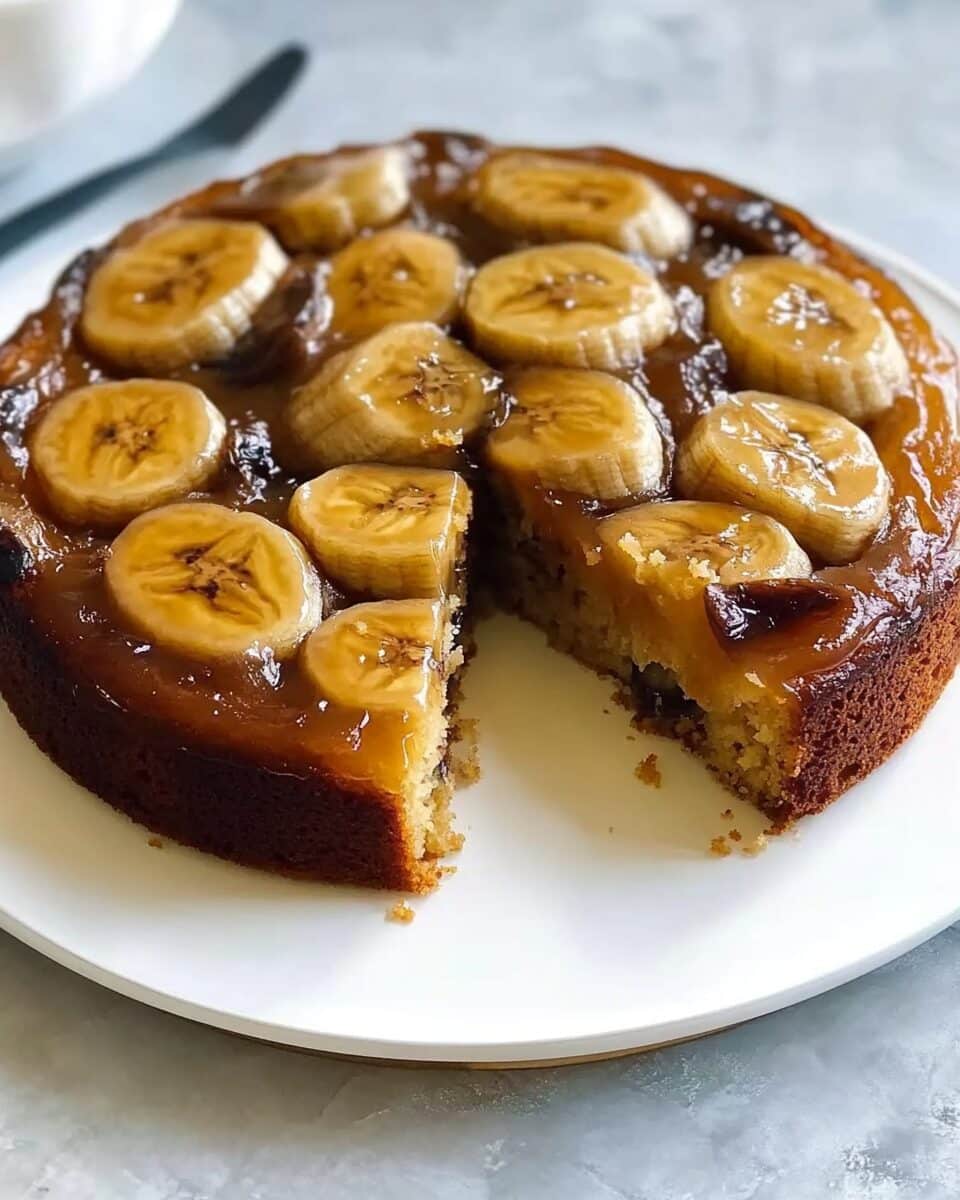Why This Recipe Stands Out
There are countless banana cakes and upside-down variations out there, but this particular recipe truly captures the magic of both. The use of cream cheese in the batter introduces a subtle tang and contributes to the cake’s lush texture without overwhelming the banana flavor. Meanwhile, sour cream adds moisture and a delicate richness that keeps the cake soft for days.
The topping is equally important. The banana slices, nestled into a blend of melted butter and brown sugar, cook down into a sticky, candy-like layer that contrasts beautifully with the fluffy cake. The visual appeal is undeniable: once inverted, the top of the cake glistens with caramelized bananas in an almost mosaic-like arrangement. It looks elegant on a dessert table yet feels approachable enough to enjoy with a simple cup of coffee or tea.
This is not a dry or overly sweet cake; it strikes a perfect balance. The caramel topping isn’t cloying thanks to the use of brown sugar, which provides a depth of flavor that white sugar alone cannot achieve. Paired with the mild tang of the batter and the mellow sweetness of bananas, it creates a well-rounded taste experience that appeals to both adults and kids alike.
The Appeal of Upside Down Cakes
Upside down cakes have a nostalgic charm that goes beyond their clever baking method. Inverting the cake after baking creates a striking visual, often revealing perfectly arranged fruit in a glossy syrup. It’s a reminder that sometimes the best surprises come when you flip things upside down—literally.
What’s particularly lovely about upside down cakes is that they bake and serve all in one pan. There’s no need for fancy layering or decoration; the topping is built right into the baking process. The simplicity of preparation, combined with the impressive result, makes this cake a popular choice for those who want something beautiful without a lot of fuss. And when bananas are involved, the payoff becomes even more rewarding.
Bananas lend themselves especially well to this format. As they bake, their sugars intensify and their texture becomes almost creamy. Unlike firmer fruits like pineapple or apple, bananas melt slightly into the brown sugar base, creating an ultra-smooth layer that soaks into the top of the cake just enough to keep it tender and flavorful without being soggy.
Perfect Occasions to Serve It
This Banana Upside Down Cake is versatile enough to be served at a variety of occasions. It makes a perfect addition to weekend brunches, potlucks, holiday desserts, and even casual family dinners. Because it’s not too rich or overpowering, it pairs well with many other dishes and can be enjoyed any time of day.
Want to impress guests at a dinner party? Serve it slightly warm with a scoop of vanilla bean ice cream or a drizzle of salted caramel sauce. Looking for a cozy treat with your morning coffee? A plain slice of this cake is just right on its own. It also travels well, making it a great choice to bring along to gatherings or give as a homemade gift.
The Texture and Taste Experience
The cake itself is ultra-soft without being overly fragile. Thanks to the combination of cream cheese and sour cream, the batter bakes up dense enough to support the moist banana topping yet tender enough to melt in your mouth. The crumb has a fine structure, meaning it cuts cleanly and doesn’t crumble—ideal for serving neat slices at events.
The bananas on top become the stars of the show after baking. Slightly caramelized, soft, and deeply flavorful, they infuse each bite with that familiar banana taste while also giving a textural contrast to the cake. The top (once inverted) is slightly sticky and glossy, which adds to the sensory enjoyment of eating it. Each mouthful is a mix of tender cake, creamy fruit, and that unmistakable buttery sugar coating.
Tips for Success
While this recipe is fairly straightforward, there are a few tips to ensure the best results. First, choose bananas that are fully ripe—those with plenty of brown spots on the peel. These will provide the best natural sweetness and the softest texture. For even caramelization, slice the bananas evenly and arrange them carefully in the pan before adding the batter.
When it comes to baking, resist the urge to check the cake too early. Upside-down cakes benefit from uninterrupted heat so the sugar can fully caramelize and the fruit can cook down properly. After baking, let the cake rest in the pan for about 10 minutes before inverting; this allows the syrup to thicken slightly and helps prevent sticking.
Lastly, serve the cake slightly warm for the ultimate flavor and texture. However, it also keeps beautifully at room temperature and can be refrigerated and reheated gently if needed.
Health Considerations and Variations
While this cake is definitely a dessert indulgence, it uses relatively wholesome ingredients—bananas, sour cream, cream cheese—which offer some nutritional value compared to heavily processed sweets. Bananas are a good source of potassium and dietary fiber, while sour cream and cream cheese contribute protein and calcium.
For a healthier twist, you can experiment with substituting part of the all-purpose flour with whole wheat flour or almond flour. Using Greek yogurt in place of sour cream is another way to boost protein while keeping the texture moist. If you’re watching your sugar intake, reducing the brown sugar topping slightly or using a sugar substitute can make this cake a little lighter without compromising the overall experience.
Conclusion
This Banana Upside Down Cake is more than just a clever use of ripe bananas—it’s a celebration of contrast and comfort. With its velvety, caramelized top and plush, moist crumb, it delivers a memorable dessert experience that feels both nostalgic and refreshingly unique. The combination of banana, brown sugar, sour cream, and cream cheese ensures a cake that’s tender, flavorful, and beautifully balanced. Whether you’re serving it warm with ice cream or enjoying a slice with your morning coffee, this cake has all the charm of a homemade treat and the elegance of a patisserie delight. It’s a recipe you’ll want to return to again and again—not just for the taste, but for the joy it brings to any table.






